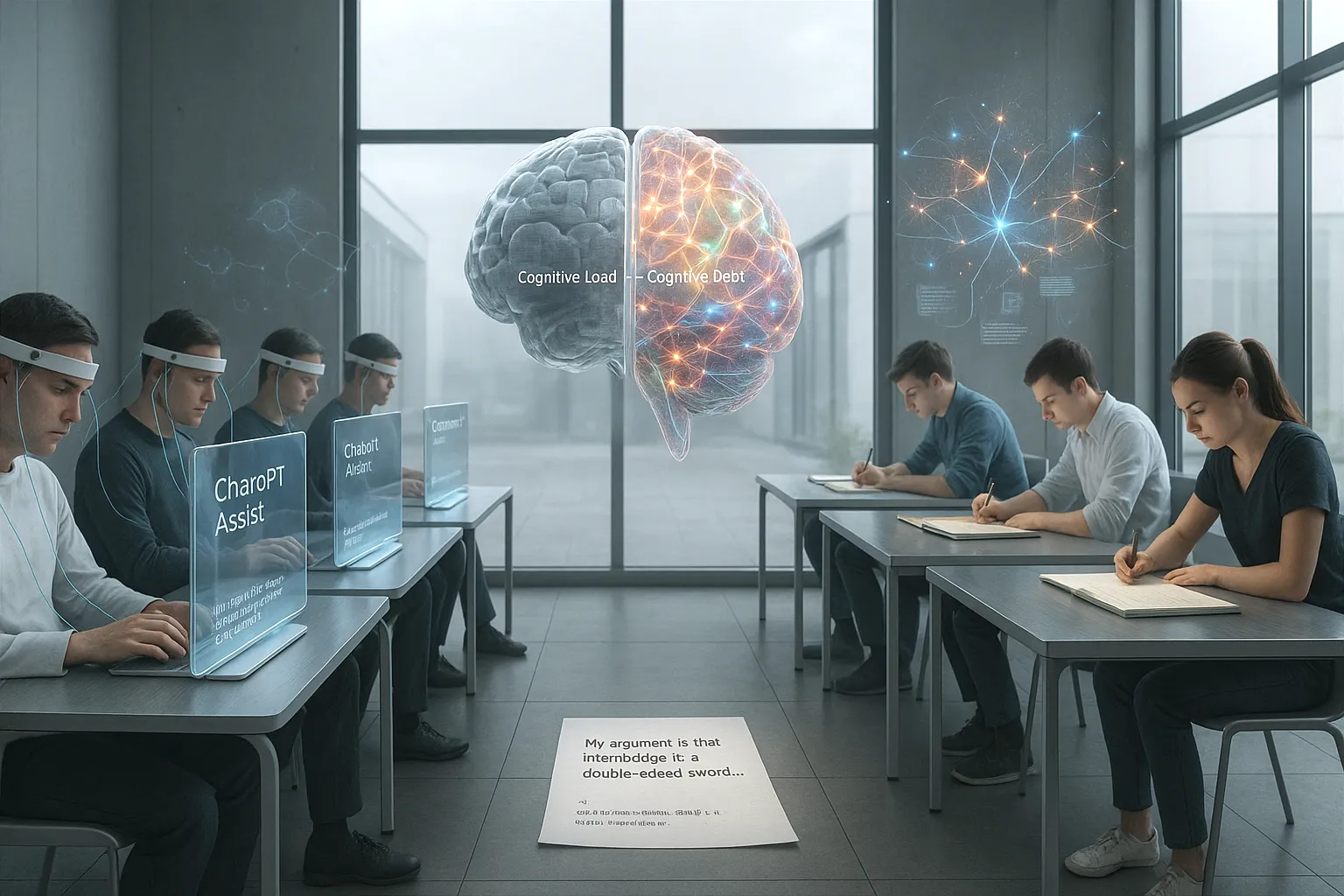💡 TL;DR - The 30 Seconds Version
🧠 MIT researchers monitored 54 students' brains while writing essays and found ChatGPT users showed weaker neural activity across all frequency bands.
📊 83% of ChatGPT users failed to quote from essays they had just written, while students writing independently quoted themselves accurately.
⚡ Students who switched from ChatGPT to independent writing couldn't restore normal brain connectivity patterns in later sessions.
📝 Essays written with ChatGPT became increasingly similar to each other, showing reduced creativity and individual voice compared to independent writers.
🔬 The study tracked participants over four months using 32-channel EEG headsets to measure real-time brain activity during writing tasks.
🚨 AI writing assistance creates "cognitive debt" that weakens thinking skills even after you stop using the tools.
MIT researchers hooked 54 students up to brain monitors and watched what happened when they wrote essays. Some students used ChatGPT. Others used Google. A third group relied on their own minds.
The results show AI assistance comes with a hidden cost. Students who used ChatGPT showed weaker brain activity across all frequency bands. Their neural networks barely communicated with each other. Meanwhile, students writing without help fired up strong connections between brain regions that handle memory and deep thinking.
The four-month study tracked how different tools affected cognitive processes. Each writing session lasted 20 minutes. Students wrote essays on SAT prompts while researchers monitored their brain activity through 32-channel EEG headsets.
The memory gap widens
The memory test revealed the starkest difference. When asked to quote from essays they had just written, 83% of ChatGPT users failed. Students who wrote independently quoted themselves accurately.
This memory deficit appeared immediately and persisted across all sessions. It correlated directly with reduced brain connectivity in areas responsible for encoding information into long-term memory.
Brain scans showed that ChatGPT users had significantly lower activity in the alpha frequency band, which handles semantic processing. Their brains simply weren't working as hard to generate ideas or process meaning.
The cognitive debt trap
Researchers identified something they call "cognitive debt." ChatGPT users offloaded so much mental work to the AI that their brains went idle. This created immediate relief but set up long-term problems.
The debt became clear in the final session when students switched tools. ChatGPT users who moved to writing alone couldn't snap back to normal brain function. They still showed weaker neural activity than students who had been writing independently all along.
Students moving from independent writing to ChatGPT showed the opposite pattern. Their brains spiked with activity as they tried to reconcile their own knowledge with AI suggestions. They were working harder, not easier.
Your voice gets lost in the machine
Language analysis found another troubling pattern. Essays written with ChatGPT became increasingly similar to each other. Students lost their individual voices and started using the same AI-generated phrases and structures.
The AI group showed twice as many named entities as other groups. They favored third-person language and career-focused terminology. Their essays converged toward a generic, ChatGPT-influenced style.
Students writing independently produced the most diverse and creative language. Google users fell somewhere between, picking up SEO-optimized keywords but maintaining more originality than the AI group.
The ownership problem
Students also reported different feelings about their work. Those writing independently felt full ownership of their essays. ChatGPT users showed fragmented ownership ranging from complete to none.
This shift represents more than just academic concern. It points to a fundamental change in how people relate to their own thinking and creative output.
The neural evidence
The brain data backs up these behavioral observations. ChatGPT users showed reduced connectivity in four key frequency bands:
Alpha waves (8-12 Hz) handle semantic processing and idea generation. ChatGPT users had weaker alpha connectivity, suggesting less self-driven thinking.
Beta waves (12-30 Hz) manage cognitive control and sustained attention. Brain-only users showed much stronger beta activity, indicating greater mental engagement.
Theta waves (4-8 Hz) support working memory and executive control. ChatGPT users had markedly lower theta connectivity, consistent with reduced mental effort.
Delta waves (0.1-4 Hz) coordinate broad brain networks. The largest group differences appeared here, with independent writers showing extensive networks needed for effortful internal tasks.
What this means for learning
The findings challenge common assumptions about AI in education. While ChatGPT reduces cognitive load and makes writing feel easier, it may undermine the mental processes necessary for learning and skill development.
The researchers draw parallels to the "Google Effect," where people remember where to find information rather than the information itself. But this goes further. ChatGPT affects active cognitive processes like reasoning and writing, not just memory storage.
The study suggests several approaches for educators. Students should develop strong independent writing skills before using AI assistance. Alternating between AI-assisted and unassisted tasks might help maintain cognitive engagement. Most importantly, students need explicit instruction about AI limitations and cognitive dependencies.
The bigger picture
These effects extend beyond education. As AI becomes more common in professional work, similar patterns of cognitive offloading may emerge across many domains.
The research also raises questions about human agency in an AI-augmented world. If our tools shape our thinking patterns, we need to choose them carefully.
The energy cost adds another dimension. LLM queries require significantly more energy than traditional web searches, making the cognitive trade-offs even more consequential.
Looking ahead
The study has limitations. It focused on one task type with a narrow demographic sample. Future research needs to examine diverse populations, multiple AI models, and longer-term effects.
The researchers note an increasing challenge: studying "pure" human cognition becomes harder as AI-generated content appears everywhere. This makes current research urgent before such effects become universal.
Why this matters:
- AI writing tools may weaken the exact thinking skills they claim to enhance, creating "cognitive debt" that persists even after you stop using them
- Your brain adapts to expect AI help, making independent thinking measurably harder and less creative over time
Read on, my dear:
❓ Frequently Asked Questions
Q: How long did the cognitive effects last after students stopped using ChatGPT?
A: The study only tracked students for one session after switching tools. ChatGPT users who moved to independent writing still showed weaker brain connectivity compared to students who had been writing alone from the start. The researchers didn't test how long these effects persist.
Q: What specific brain regions were most affected by ChatGPT use?
A: The fronto-parietal network showed the biggest changes. This brain network handles working memory, semantic processing, and executive control. ChatGPT users had significantly weaker connections in this area across alpha, beta, and theta frequency bands measured by the 32-channel EEG headsets.
Q: Did students using Google search show similar brain changes to ChatGPT users?
A: No. Google users fell between ChatGPT users and independent writers on most measures. They showed increased visual cortex activity from reading search results but maintained stronger overall brain connectivity than ChatGPT users. Their memory recall remained accurate unlike ChatGPT users.
Q: How many students participated and what was their age range?
A: 54 students aged 18-39 from five Boston-area universities participated over four months. They were randomly split into three equal groups of 18 people each. All participants completed multiple 20-minute essay writing sessions while wearing EEG brain monitoring equipment.
Q: What specific ChatGPT model did the study use?
A: The researchers used OpenAI's GPT-4o model. Students in the ChatGPT group used this model exclusively for all their essay writing tasks. The study found that 38% of student prompts in early sessions requested direct essay and writing help.
Q: How much energy does ChatGPT use compared to Google search?
A: The study notes that LLM queries require "significantly higher energy" than traditional web searches but doesn't provide exact numbers. This energy cost adds another dimension to the cognitive trade-offs the researchers identified in their brain monitoring data.
Q: Could students tell the difference in their own thinking when switching tools?
A: Students moving from ChatGPT to independent writing didn't notice their reduced brain activity, but those switching from independent writing to ChatGPT immediately felt the change. Their brains showed spikes across all frequency bands as they worked to integrate AI suggestions with their own knowledge.








